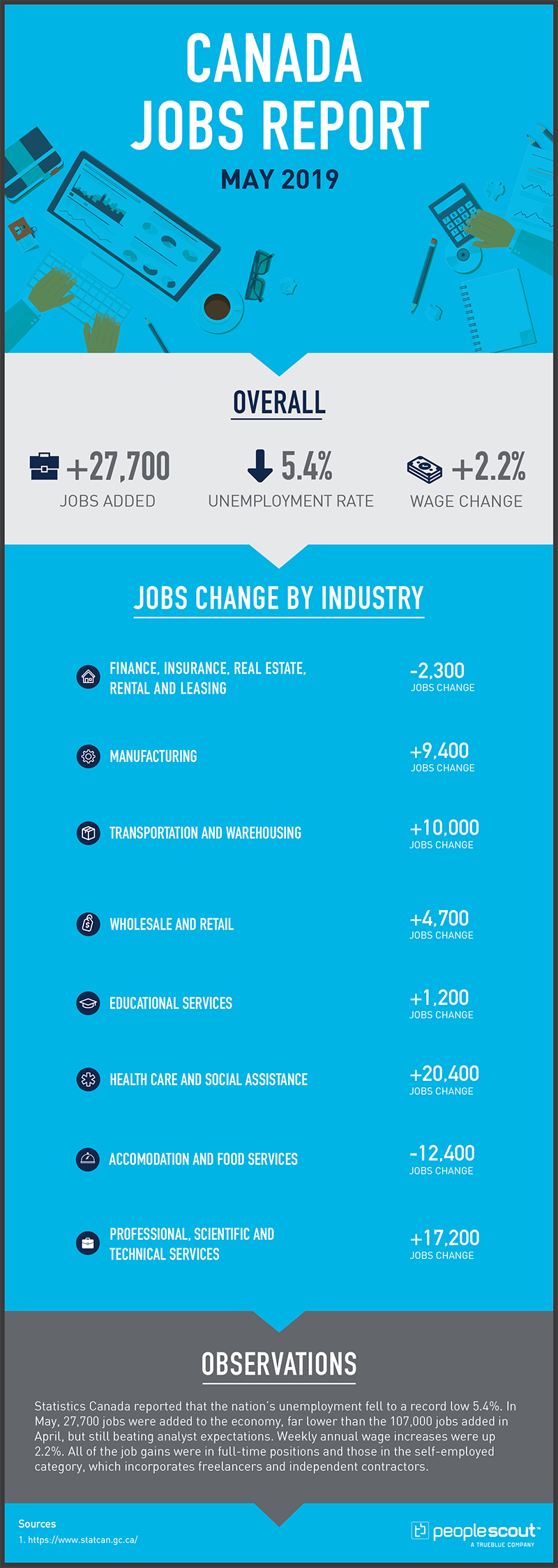Statistics Canada reported that the nation’s unemployment fell to a record low 5.4%. In May, 27,700 jobs were added to the economy, far lower than the 107,000 jobs added in April, but still beating analyst expectations. Weekly annual wage increases were up 2.2%. All of the job gains were in full-time positions and those in the self-employed category, which incorporates freelancers and independent contractors.

The Numbers
27,000: The economy added 27,700 jobs in May.
5.4%: The unemployment rate fell to at 5.4%.
2.2%: Weekly wages increased 2.2% over the last year.
The Good
Statistics Canada reported that the nation’s unemployment fell to 5.4%, a record low. The economy added 27,700 jobs, far ahead of analyst expectations. The job gains in May came from full-time work and from the self-employed category. Over the past year, employment grew by 453,000 or 2.4%, reflecting gains in both full-time (+299,000) and part-time (+154,000) work. This is the biggest year-over-year increase since before the 2008-2009 recession.
Employment in Ontario rose by 21,000 in May, with notable increases among the core-aged population and among women. Three other provinces had net job increases; British Columbia at 17,000, Nova Scotia at 4.500 and New Brunswick at 3,000. There were 20,000 more people working in health care and social assistance in May, bringing year-over-year gains in this industry to 89,000 (+3.7%). Over half of the monthly increase in this sector was in Ontario.
Employment in professional, scientific and technical services was up 17,000, more than offsetting a decline in the previous month. The increase in May was concentrated in Ontario, while smaller increases were also registered in New Brunswick and Saskatchewan. Compared with 12 months earlier, employment in this industry grew by 67,000 (+4.5%). Employment in transportation and warehousing grew by 10,000, driven by increases in Ontario and Alberta. On a year-over-year basis, employment in this sector rose by 60,000 (+5.6%).
The Bad
Despite record low unemployment, the rate of wage growth is still disappointing. In August 2018, annual average weekly wage increases stood at 2.9% while in May it was just 2.2%. Sluggish wage growth impacts the purchasing power of Canadian consumers and can have a negative effect in the overall economy.
Employment in Newfoundland and Labrador was down 2,700, due to losses in part-time work. The unemployment rate there rose by 0.7 percentage points to 12.4%. The robust job increases in Ontario and British Columbia were not shared by Quebec and other provinces which saw little change in their employment situation.
In May, 19,000 fewer people were working in business, building and other support services, mostly due to declines in Quebec and Alberta. Employment in accommodation and food services was down by 12,400, the fourth decline in the last five months. Employment in this industry has been trending down since May 2018, decreasing by 63,000 (-5.0%) over the year.
The Unknown
The number of self-employed workers rose by 62,000 in May. Compared with 12 months earlier, the number of self-employed rose by 93,000 (+3.3%) The self-employed category includes independent contractors and freelancers.
It is unclear why approximately two-thirds of the increase in self-employed workers over the last year took place in May, or whether this rate of growth will continue. Yet if the number of Canadians that opt out of traditional employment situations continues to increase rapidly, it will strain efforts of employers who are attempting to recruit and retain full-time talent at a time of record-low unemployment. The coming months should provide clarity as to whether the rapid increase in self-employed workers in May was an aberration or an indicator of a significant shift in the nature of the Canadian workforce.




